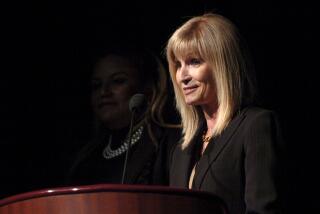MEDIA : Some Winners, Some Losers in Radio Ratings Game
- Share via
The Arbitron ratings released last week for the summer quarter brought local radio stations the usual grab bag of good news and bad news, glaring signs and mixed signals. There were few bombshells, but the ratings provided plenty of fodder for industry professionals to seriously discuss over their morning coffee.
Popular topics of conversation included:
* The KFMB-FM (B100) morning team of Jeff Elliott and Jerry St. James may not have come up with an original routine since David Letterman went on the air--and they certainly don’t make anybody laugh as much as they make themselves laugh--but they are undoubtedly dominating morning radio. Backed by a series of television commercials, “Jeff and Jer” posted a 9.5 rating share among listeners 12 and over and an impressive 11.8 share in the key 25-54 age group.
The book also makes it clear that Mike Berger and Jeff Prescott, who made a much trumpeted “defection” from KGB-FM (101.5) to XTRA-FM (91X) last year, are having little impact at their new station. Berger and Prescott posted a 3.9 share, ranking them eighth in the 12-plus category.
The much ballyhooed husband-wife team of Ron Stevens and Joy Grdnic has had similar uninspiring results at KKYY-FM (Y95). The duo was unable to muster anything better than a 3.0 share in the 25-54 category.
* Overall, KKLQ (Q106) continued its remarkable string of ratings victories with its incessantly perky Top 40 dance music. In a business where consistency is a rarity, Q106 won the 12-plus category for the 12th consecutive rating period with a 9.1 share.
However, XHTZ-FM (Z90), which switched its format last year with an eye toward competing against Q106, showed signs that it is moving toward the realm of respectability with a 2.9 share in the 12-plus category, up from a 1.9 in the spring.
B100 had a strong book overall, placing second in 12-plus category with a 6.6 share, and first among listeners age 25-54 with an 8.5 share.
The country format of KSON, simulcast on AM (1240) and FM (97.3), is clearly more than a ratings fluke. Although it slipped slightly from its strong spring showing, KSON still placed third in the 12-plus category with a 6.5 share, and second in age 25-54 with an 8.4. It will be interesting to see whether KSON can maintain its momentum now that morning personality Jack Diamond has left.
* A year ago, KJQY-FM (Sunny 103) “repositioned” its music programming to directly compete against KYXY-FM (96.5) for the “easy listening” audience. The summer book shows KJQY making steady improvement, increasing from a 4.4 in the spring to a 5.2 rating share among listeners 12 and over, while KYXY slipped from a 3.7 to a 3.0.
“It’s a 15 round fight and I’ve been in a whole lot of 15 round fights,” said KYXY General Manager Jim Price. “They won round one, but I’ve always been standing there in the 15th.”
Sunny 103 was heavily promoted on television during the ratings period. KYXY has counterattacked with its own television ad campaign, which didn’t begin until the end of the ratings period.
* For the second consecutive summer, KGB-FM (101.5) took a ratings dive. KGB’s album-oriented rock managed only a 4.9 among listeners 12 and over, down from a 7.1 in the spring. KGB’s main competition, 91X and KSDO-FM (Classic 103), didn’t make large gains, so it’s not like another station is stealing KGB’s audience.
“I don’t know why it happens in the summer,” program director Ted Edwards said.
Edwards emphasized that the Birch survey, which uses different methodology than Arbitron, showed KGB in second, behind Q106. But there is little doubt that once-powerful KGB has lost something of its ratings supremacy.
In the last year, KGB has been reacting to the new competition of Classic 103 by “reemphasizing” classic rock ‘n’ roll. Speculation in the industry suggests that the emphasis on classic rock may have hurt KGB’s overall ratings.
“If that were true, then the Birch (rating) would have fallen too,” Edwards said.
Television is an inexact medium. Words and phrases flippantly tossed about as part of the conversational approach can be extremely damaging. Last week Charger linebacker Billy Ray Smith confronted Channel 10 sports guy Larry Sacknoff during a weekly on-air segment over the use of one word.
Smith was upset that Sacknoff refered to Charger lineman Joe Phillip’s companion the night he was attacked as his “girlfriend.” Smith demanded an apology. Sacknoff refused.
Beyond the titillating aspects of the argument--oh, my, how will this affect Sacknoff’s relationship with Smith’s wife, Channel 10 co-anchor Kimberly Hunt?--there is the very real issue of Channel 10 labeling the married Phillips as a philanderer.
Sacknoff says the term “girlfriend” was used in the copy given him, which is the proverbial passing of the buck. He and Channel 10 executives say they stick to the accuracy of the word, but they changed to “female companion” in later broadcasts.
“We certainly didn’t set out to hurt Joe Phillips or his wife,” Sacknoff said. “Our sources said she was a girlfriend.”
Even though he is paid to appear on Channel 10 on a weekly basis, Smith was certainly justified in complaining, since he is paid to represent the Chargers’ viewpoint. It’s too bad Sacknoff was not better prepared to answer his charges and to discuss the very real issues involved. Television doesn’t have the same mechanism to correct errors as newspapers.
“If we made a mistake, and I told this to Larry, it was that we didn’t attribute (the term girlfriend) to sources,” news director Paul Sands said.
The 7-year-old monthly San Diego Executive magazine is out with a new design and expanded form, the result of a $500,000 influx of capital from Alfred Gooding, the industrialist brother of editor Margaret Gooding.
The mag claims a “controlled circulation” of 23,000, which basically means the magazine is free, but only to the right type of reader--in this case “business owners who make more than $300,000 in annual sales,” according to publisher Mary Ann Czerwinski.
The new and improved magazine also includes a new “editorial advisory board,” which includes such San Diego business promoters as Dan Pegg of the San Diego Economic Development Corp. and Dal Watkins of the Convention & Visitor’s Bureau.
Though some may look at the new board and wonder if the magazine is going to become a cheerleader for the local business community, Czerwinski said the group will only advise the magazine, and keep it focused on the “people, trends and issues” in San Diego.


